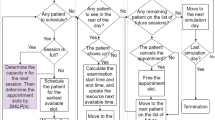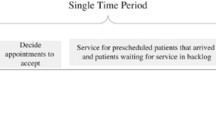Abstract
Outpatient appointment scheduling balances efficiency with access to healthcare services, yet appointment no-shows, cancellations, and delay are significant barriers to effective healthcare delivery. Patients with longer appointment delay often waste appointments more frequently, prompting a need for greater flexibility in appointment allocation. We present a joint capacity control and overbooking model where a clinic maximizes profits by controlling bookings from two sequential patient classes with different no-show rates. When booking advance requests, the clinic must balance high no-show probability with the probability of subsequent requests at lower waste rates. We show the optimal policy is computationally intensive to derive; therefore, we develop bounds and approximations which we compare via numerical study with the optimal policy as well as policies from practice and previous literature. We find the optimal policy increases profits 17.8% over first-come-first-serve allocation. We develop a simple policy which performs 0.3% below optimal on average. While pure open access can achieve optimality, it performs 23.0% below optimal on average.





Similar content being viewed by others
References
Belardi FG, Weir S, Craig FW (2004) A controlled trial of an advanced access appointment system in a residency family medicine center. Fam Med 36(5):341–345
Belobaba PP (1989) Application of a probabilistic decision model to airline seat inventory control. Oper Res 37(2):183–197
Bundy DG, Randolph GD, Murray M, Anderson J, Margolis PA (2005) Open access in primary care: results of a north carolina pilot project. Pediatrics 116(1):82
Cayirli T, Veral E (2003) Outpatient scheduling in health care: a review of literature. Prod Oper Manag 12(4):519–549
Cayirli T, Veral E, Rosen H (2006) Designing appointment scheduling systems for ambulatory care services. Health Care Manag Sci 9(1):47–58
Chakraborty S, Muthuraman K, Lawley M (2010) Sequential clinical scheduling with patient no-shows and general service time distributions. IIE Trans 42(5):354–366
Denton B, Gupta D (2003) A sequential bounding approach for optimal appointment scheduling. IIE Trans 35(11):1003–1016
Dixon S, Sampson FC, O’Cathain A, Pickin M (2006) Advanced access: more than just gp waiting times? Fam Pract 23(2):233
Festinger DS, Lamb RJ, Marlowe DB, Kirby KC (2002) From telephone to office: intake attendance as a function of appointment delay. Addict Behav 27(1):131–137
Gallucci G, Swartz W, Hackerman F (2005) Brief reports: impact of the wait for an initial appointment on the rate of kept appointments at a mental health center. Psychiatr Serv 56(3):344
Giachetti RE (2008) A simulation study of interventions to reduce appointment lead-time and patient no-show rate. In: Simulation conference, 2008. WSC 2008, Winter, pp 1463–1468
Giachetti RE, Centeno EA, Centeno MA, Sundaram R (2005) Assessing the viability of an open access policy in an outpatient clinic: a discrete-event and continuous simulation modeling approach. In: Proceedings of the 37th conference on Winter simulation, p 2255
Green LV, Savin S (2008) Reducing delays for medical appointments: a queueing approach. Oper Res 56(6):1526–1538
Green LV, Savin S, Murray M (2007) Providing timely access to care: what is the right patient panel size? Joint Comm J Qual Patient Saf 33(4):211–218
Gupta D, Denton B (2008) Appointment scheduling in health care: challenges and opportunities. IIE Trans 40(9):800–819
Gupta D, Wang L (2008) Revenue management for a primary-care clinic in the presence of patient choice. Oper Res 56(3):576–592
Kaandorp GC, Koole G (2007) Optimal outpatient appointment scheduling. Health Care Manag Sci 10(3):217–229
Kim S, Giachetti RE (2006) A Stochastic mathematical appointment overbooking model for healthcare providers to improve profits. IEEE Trans Syst Manufact Cybern Part A Syst Hum 36(6):1211
Kopach R, DeLaurentis PC, Lawley M, Muthuraman K, Ozsen L, Rardin R, Wan H, Intrevado P, Qu X, Willis D (2007) Effects of clinical characteristics on successful open access scheduling. Health Care Manag Sci 10(2):111–124
LaGanga LR, Lawrence SR (2007) Clinic overbooking to improve patient access and increase provider productivity. Decis Sci 38(2):251–276
Lamb A (2002) Why advanced access is a retrograde step. Br J Gen Pract 52(485):1035
Littlewood K (1972) Forecasting and control of passenger bookings. In: AGIFORS symposium proceedings, vol 12, pp 19–117
Liu N, Ziya S, Kulkarni VG (2010) Dynamic scheduling of outpatient appointments under patient no-shows and cancellations. Manufact Serv Oper Manag 12(2):347–364
Mehrotra A, Keehl-Markowitz L, Ayanian JZ (2008) Implementing open-access scheduling of visits in primary care practices: a cautionary tale. Annal Intern Med 148(12):915
Moore CG, Wilson-Witherspoon P, Probst JC (2001) Time and money: effects of no-shows at a family practice residency clinic. Fam Med 33(7):522–527
Murray M, Berwick DM (2003) Advanced access: reducing waiting and delays in primary care. JAMA 289(8):1035
Murray MM, Tantau C (2000) Same-day appointments: exploding the access paradigm. Fam Pract Manag 7(8):45
Muthuraman K, Lawley M (2008) A stochastic overbooking model for outpatient clinical scheduling with no-shows. IIE Trans 40(9):820–837
Qu X, Rardin RL, Williams JAS, Willis DR (2007) Matching daily healthcare provider capacity to demand in advanced access scheduling systems. Eur J Oper Res 183(2):812–826
Robinson LW, Chen RR (2010) A comparison of traditional and open-access policies for appointment scheduling. Manufact Serv Oper Manag 12(2):330–346
Shaked M, Shanthikumar JG (2007) Stochastic orders. Springer, New York
Solberg LI, Maciosek MV, Sperl-Hillen JA, Crain AL, Engebretson KI, Asplin BR, O’Connor PJ (2004) Does improved access to care affect utilization and costs for patients with chronic conditions. Am J Manag Care 10(10):717–722
Strunk BC, Cunningham PJ (2002) Treading water: Americans’ access to needed medical care, 1997–2001, vol 1. Tracking report—senter for studying health system change, p 1
Subramanian J, Stidham S, Lautenbacher CJ (1999) Airline yield management with overbooking, cancellations, and no-shows. Transport Sci 33(2):147–167
Talluri KT, van Ryzin G (2005) The theory and practice of revenue management. Springer, Berlin
Zeng B, Turkcan A, Lin J, Lawley M (2009) Clinic scheduling models with overbooking for patients with heterogeneous no-show probabilities. Annal Oper Res 1–24
Acknowledgments
The authors would like to thank anonymous reviewers for the helpful comments which greatly improved the paper and the university health system which supplied the appointment scheduling data.
Author information
Authors and Affiliations
Corresponding author
Appendix
Appendix
Proof
Proposition 1. Assume x 2 Class 2 patients patients have already been booked. Assume D 1 ≥ x 1 and the clinic is considering whether or not to accept the x 1th patient. The marginal expected profit, \(\Updelta_{x_{1}}V_{0}\left(x_{2},x_{1}\right),\) of accepting an additional patient can be written as:
Since the marginal expected profit profit is decreasing in x 1, the clinic accepts Class 1 patients so long as \(\Updelta_{x_{1}}V_{0}\left(x_{2},x_{1}\right)\geq0, \) i.e. \(P\left(Z_{2}\left(x_{2}\right)>k-x_{1}\right)\leq\frac{p}{h}, \) or until all requests have been booked. \(\square\)
Proof
Proposition 2. Let \(b_{1}\left(x_{2}\right)=b_{1}\) for all values of x 2. We can write the expected overbooking cost as \(L=hE\left[Z_{2}\left(x_{2}\right)+{\hbox{min}}\left(D_{1},b_{1}\left(x_{2}\right)\right)-k\right]^{+}. \) Note that \(h\left(z+{\hbox{min}}\left(D_{1},b_{1}\right)-k\right)^{+}\) is an increasing, convex function of z. From Example 8.B.3 on page 368 of Shaked and Shanthikumar (2007) we know \(\left\{ Z_{2}\left(x_{2}\right),x_{2}=0,1,2...\right\} \) is stochastically increasing convex. Therefore, \(E\phi\left[Z_{2}\left(x_{2}\right)\right]\) is increasing and convex in x 2 for any convex function including \(hE\left[Z_{2}\left(x_{2}\right)+{\hbox{min}}\left(D_{1},b_{1}\right)-k\right]^{+}. \) Therefore, \(V_{0}\left(x_{2},b_{1}\left(x_{2}\right)\right)\) is concave in x 2 since the sum of concave functions is concave. This implies \(V_{1}\left(x_{2},0\right)\) must be concave in x 2 since the component-wise maximum of concave functions is concave. \(\square\)
Proof
Proposition 3. By definition, for any two random variables, R 1 and R 2, and increasing function ϕ
Since \(h\left[x-k\right]^{+}\) is an increasing, convex function of x, we can use stochastic ordering between \(Z_{2}\left(x_{2}\right)+{\hbox{min}}\left(D_{1},s-x_{2}\right)\) and \(Z_{2}\left(x_{2}-1\right)+{\hbox{min}}\left(D_{1},s-x_{2}+1\right)\) to determine whether the expected overbooking cost is increasing or decreasing.
If \(P\left(Z_{2}\left(x_{2}\right)-Z_{2}\left(x_{2}-1\right)>t\right)\geq P\left({\hbox{min}}\left(D_{1}s-x_{2}+1\right)-{\hbox{min}}\left(D_{1},s-x_{2}\right)>t\right)\) ∀ t then \(Z_{2}\left(x_{2}\right)\) is stochastically increasing in x 2. If the reverse is true, then \(Z_{2}\left(x_{2}\right)\) is stochastically decreasing in x 2. (Note: each difference is either 0 or 1.)
-
For t ≥ 1
-
\(P\left(Z_{2}\left(x_{2}\right)-Z_{2}\left(x_{2}-1\right)>t\right)=0=P\left({\hbox{min}}\left(D_{1},s-x_{2}+1\right)-{\hbox{min}}\left(D_{1},s-x_{2}\right)>t\right)\)
-
-
For t = 0
-
\(P\left(Z_{2}\left(x_{2}\right)-Z_{2}\left(x_{2}-1\right)>t\right)=\alpha_{2}\)
-
\(P\left({\hbox{min}}\left(D_{1},s-x_{2}+1\right)-{\hbox{min}}\left(D_{1},s-x_{2}\right)>t\right)=P\left(D_{1}\geq s-x_{2}+1\right)\)
-
-
For t < 0
-
\(P\left(Z_{2}\left(x_{2}\right)-Z_{2}\left(x_{2}-1\right)>t\right)=1=P\left({\hbox{min}}\left(D_{1},s-x_{2}+1\right)-{\hbox{min}}\left(D_{1},s-x_{2}\right)>t\right)\)
-
For any increasing function \(\phi, Z_{2}\left(x_{2}\right)\) is stochastically increasing in x 2 and \(E\phi\left(Z_{2}\left(x_{2}\right)\right)\) is increasing in x 2 if \(\alpha_{2}\geq P\left(D_{1}\geq s-x_{2}+1\right). \) \(\square\)
Proof
Proposition 4. Let superscripts A and B denote the two cases, respectively, where the Class 1 booking limit stays constant or decreases by one.
Case A: \(b_{1}\left(x_{2}\right)=b_{1}\left(x_{2}-1\right)\)
If the x 2th customer does not attend,
If the x 2th customer attends and Class 1 demand is at least \(b_{1}\left(x_{2}-1\right), \)
If the x 2th customer attends and Class 1 demand is equal to \(d<b_{1}\left(x_{2}-1\right), \)
Conditioning upon these sub-cases we write the marginal expected profit as
where
Case B \(b_{1}\left(x\right)=b_{1}\left(x_{2}-1\right)-1\)
Conditioning on sub-cases as in Case A, we derive the marginal change in expected overbooks as follows and write the marginal expected profit for Case B as
\(\square\)
Rights and permissions
About this article
Cite this article
Ratcliffe, A., Gilland, W. & Marucheck, A. Revenue management for outpatient appointments: joint capacity control and overbooking with class-dependent no-shows. Flex Serv Manuf J 24, 516–548 (2012). https://doi.org/10.1007/s10696-011-9129-9
Published:
Issue Date:
DOI: https://doi.org/10.1007/s10696-011-9129-9




